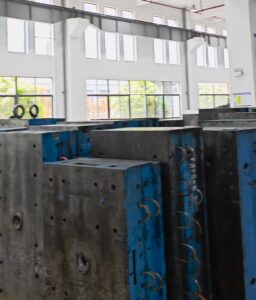In modern manufacturing, molds serve as the backbone of production, critical for industries from automotive to electronics. Yet traditional mold management—reliant on manual tracking and paper records—often leads to inefficiencies: lost molds, downtime from misplaced tools, and unplanned maintenance. The convergence of RFID (Радиочастотная идентификация) technology and cloud-based smart factories is revolutionizing this landscape, transforming outdated processes into data-driven, real-time systems.
The Digital Transformation: RFID as the Bridge
RFID technology acts as the foundational layer for smart mold management. By attaching durable, industrial-grade RFID tags—engineered to withstand high temperatures (up to 200°C) and harsh environments—to each mold, manufacturers assign a unique “digital identity” to every asset. These tags store critical data: mold specifications, maintenance history, and even real-time performance metrics. When paired with cloud platforms, this creates a seamless ecosystem where physical molds interact with digital systems, enabling end-to-end visibility across the entire lifecycle.
 1.Real-Time Tracking: Eliminating Downtime and Errors
1.Real-Time Tracking: Eliminating Downtime and Errors
In traditional setups, locating a specific mold in a warehouse or workshop can take up to 30 минут, leading to costly machine downtime. RFID changes this: fixed readers at entry points and workstations automatically detect molds as they move, updating their location in the cloud in real time. A leading German automotive supplier reduced mold search time by 90%, cutting annual downtime equivalent to 2,000 production hours.
The cloud platform also acts as a central hub for error prevention. When a mold is incorrectly paired with a machine (Например, using a high-pressure mold for low-temperature materials), the system triggers instant alerts, preventing costly quality defects. One electronics manufacturer in Japan reported a 75% drop in mold-related product errors after implementing this system.
2.Профилактическое обслуживание: Extending Mold Lifespan
Molds degrade over time, but unplanned breakdowns are avoidable with data. RFID метки, combined with sensors, collect usage data—number of cycles, pressure levels, temperature fluctuations—and send it to the cloud. Advanced algorithms analyze these patterns to predict wear and tear, scheduling maintenance before failures occur. Ðапример, a U.S. metalworking firm extended mold lifespan by 25% and reduced maintenance costs by 20% by shifting from reactive to predictive care.
The cloud stores a complete digital twin of each mold, logging every repair, part replacement, and performance metric. This historical data helps engineers optimize future designs, such as reinforcing frequently worn components, creating a feedback loop for continuous improvement.
3.Inventory Optimization: From Chaos to Control
Mold inventory management is notoriously complex, with hundreds of variants stored across facilities. Cloud-integrated RFID enables automated inventory checks: the system scans entire warehouses in minutes, updating stock levels in real time and flagging shortages or overstocking. A Mexican contract manufacturer achieved 99.9% inventory accuracy and reduced storage costs by 35% after deploying this solution.
Smart forecasting further enhances efficiency. By analyzing production schedules and mold usage trends, the cloud system predicts demand for specific molds, triggering automated reordering for replacement parts or new tools. This just-in-time approach minimizes capital tied up in idle inventory.
4.Scalability and Global Visibility
For multinational manufacturers, centralizing mold data across global sites was once impossible. Cloud-based RFID systems break down silos, providing a unified dashboard that shows mold status anywhere in the world. A French aerospace supplier now manages molds across 12 factories through a single platform, improving cross-site collaboration and reducing redundant purchases by 40%.
The cloud also future-proofs operations. As 5G and edge computing evolve, real-time data can be processed even faster, enabling microsecond-level adjustments in production. Imagine a mold sending an alert mid-cycle about unusual vibration—AI in the cloud instantly identifies a misalignment, prompting a robot to adjust settings before a defect occurs.
Implementing the Solution: A Step-by-Step Approach

Tag Deployment: Start with high-value molds, attaching RFID метки to durable locations (Например, mold bases). Ensure tags meet industry standards (Например, ISO 11784/85 for compatibility).
Reader Network: Устанавливать исправлены считыватели в ключевых точках (warehouse gates, machine stations) and equip staff with handheld readers for mobile tracking.
Cloud Integration: Choose a scalable industrial IoT platform (Например, AWS IoT, Siemens MindSphere) to host data, ensuring secure connectivity and API compatibility with existing ERP/MES systems.
User Training: Provide intuitive dashboards for operators to view mold status, the system’s AI-driven insights, reducing reliance on manual expertise.
The Future: Smarter, Быстрее, Connected
As Industry 4.0 progresses, the synergy between RFID and cloud computing will only deepen. Emerging trends like digital twins and AI-driven analytics will enable molds to “self-diagnose” issues, while blockchain could secure tamper-proof maintenance records. The result? A factory where molds aren’t just tools—they’re smart, connected assets that optimize themselves, driving efficiency, качество, and profitability to new heights.
In a world where every second of production matters, RFID-powered cloud mold management isn’t just an upgrade—it’s a necessity. By turning data into action, manufacturers can unlock a future where downtime and errors are relics of the past, and productivity soars on the wings of smart technology.






